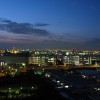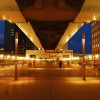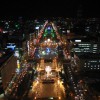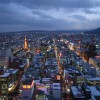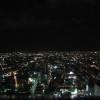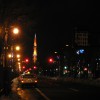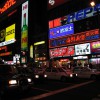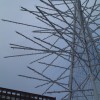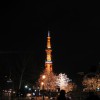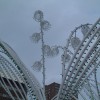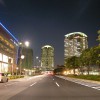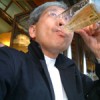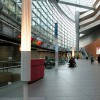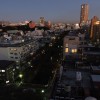国内調査:札幌・函館
北国の夜景都市をめぐる
2018/04/16-19 中村美寿々+Sherri Goh
街の夜景を楽しむという意識が高まりはじめたころから、夜景を観光資源として活用し、日本での“夜景都市”の先駆けとなった函館。しかし近年は、同じ道内で札幌の夜景を高く評価する意見も多く目にします。夜景都市のイメージを守り続ける函館と、着実な取り組みでダークホースのように魅力を増してきた札幌、北の大地が雪解けを迎えた季節に、二つの都市を調査してきました。
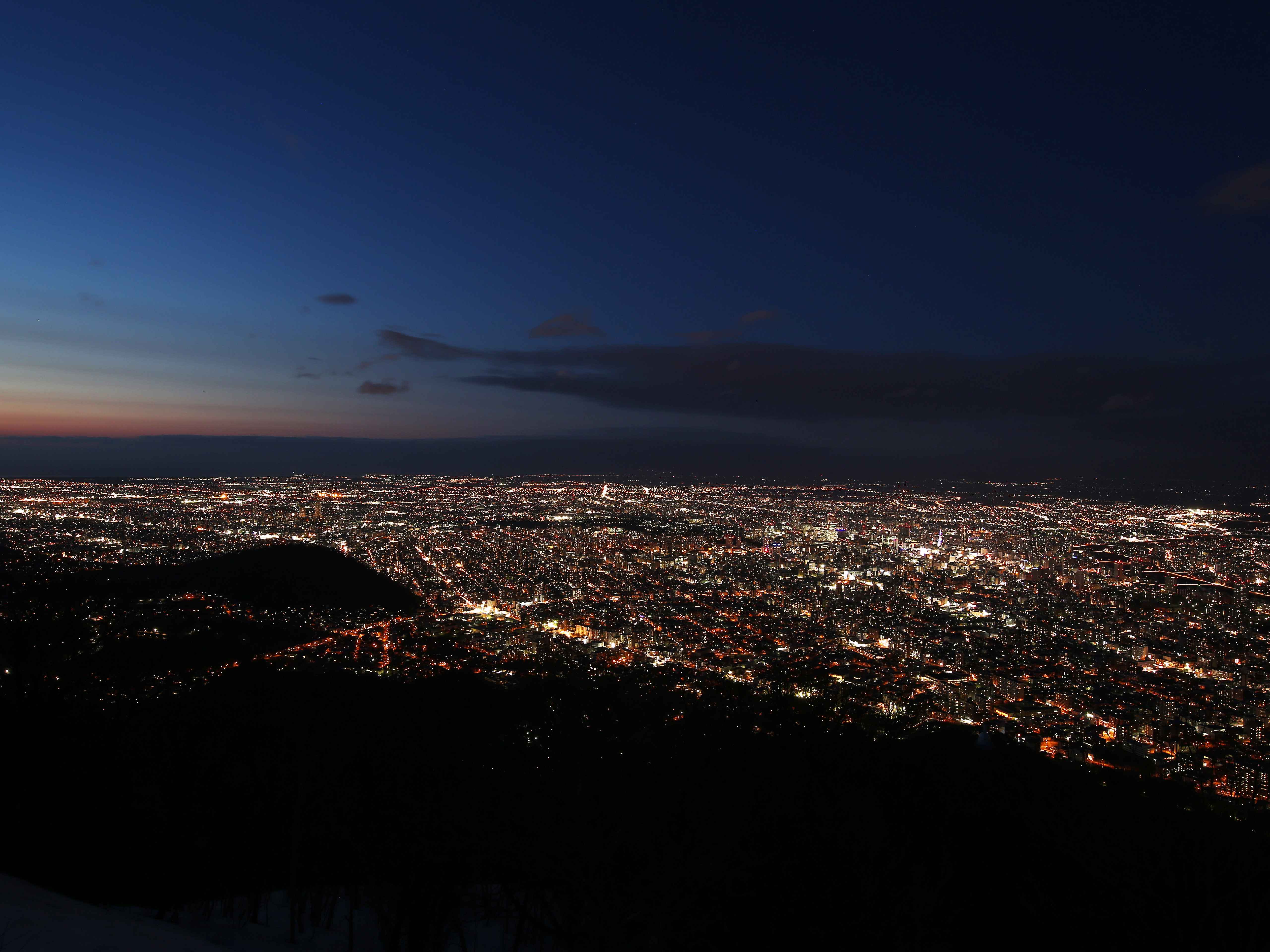
藻岩山から見た札幌。グリッド状の街路に沿った街路灯の光と、間を埋めるビルの窓明かりとが、均質な印象でどこまでも広がっている。際立って目立つライトアップなどは無く、市内の地理を特定できる光は少ない。
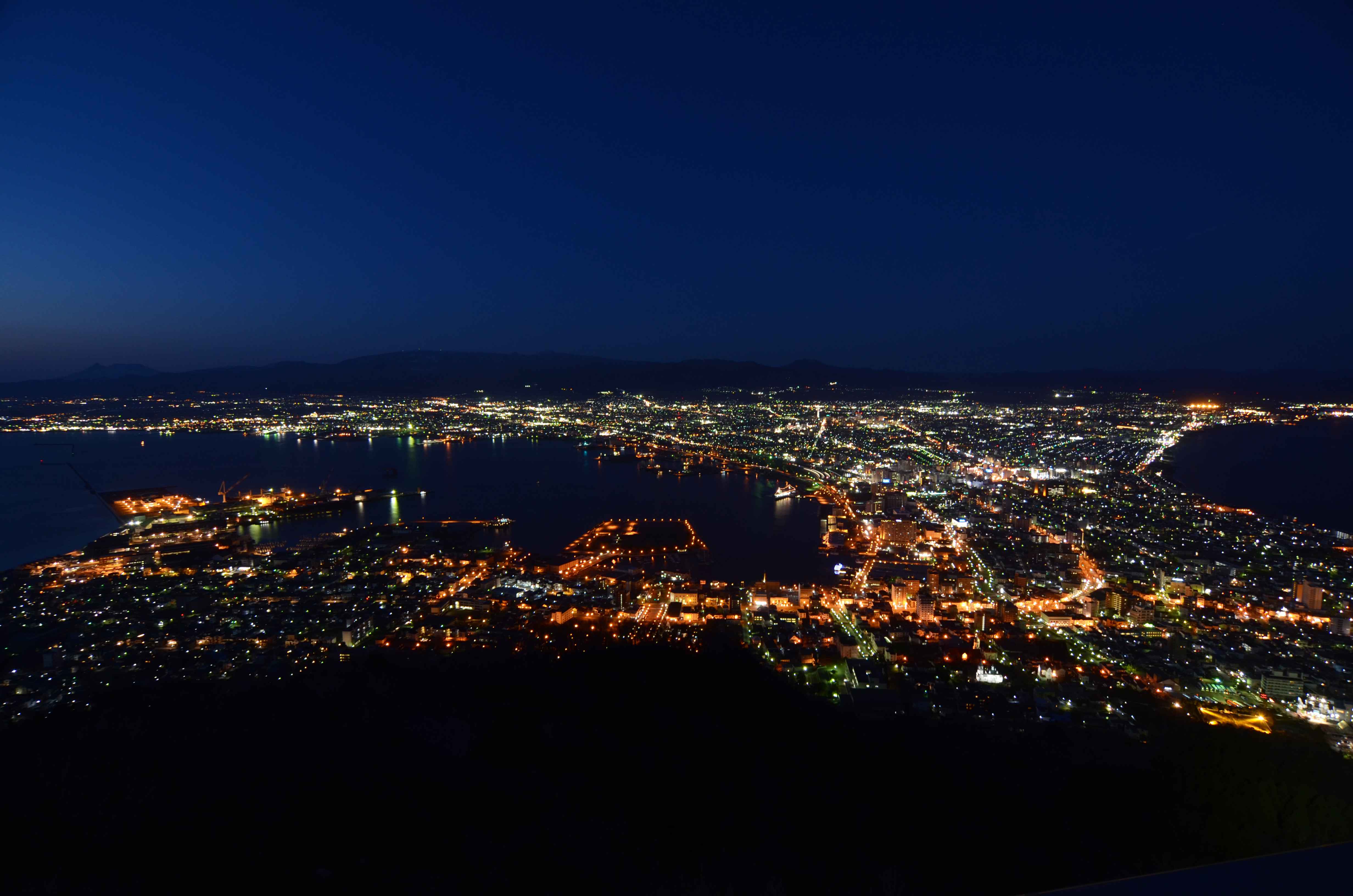
函館山から見た函館。北海道の首元を見ている!という感動を与えてくれるパノラマである。オレンジ色に目立つのは市電が走る通り。五稜郭タワーや客船や教会といったランドマークがライトアップされている。
■二つの都市の夜を俯瞰する
正直なところ、札幌の夜景にそこまでの期待はしていなかったのだが、市街地の外れに隣接する藻岩山で、展望台から見た札幌は、非常に美しかった。都市の夜景において支配的な要素となる街路灯の光は、低い色温度で統一されており、適度な輝度で整然と広がる。高さの揃ったビルの窓明かりが間を埋める。華やかではないが、温かみと静謐さを両立させた景色が、キラキラと広がっていた。
函館の夜景は、まさに見たかった景色を目にしたという感動を与えてくれた。函館山が市街地に近いこともあり、五稜郭タワーや教会や客船など、ライトアップされているランドマークが視認しやすく、歩いてきた街並みを読み取ることができる。
ただ、同時に、ビル頂部の看板照明や眩しい街路灯など、制御されていない光の要素もそのまま目に飛び込んできてしまう距離であるため、乱雑な印象も受けたが、それでも俯瞰する楽しさが勝る、魅力的な景色だった。
どちらの都市の俯瞰夜景も綺麗だったが、その質も方向性も、対称的であった。
“都市照明”と“夜景”の距離が近くなっていくのではないか、と感じている。夜景として、地形やモニュメントといった都市のポテンシャルを光でいかに魅せるか、つまり都市全体が見渡せる遠景をスタート地点として夜景の見せ方を考えていくとき、まず重要視されるのはマクロの視点であり、ランドマークの点的なライトアップであり、歩行者にとっての街路灯の眩しさや交差点の暗がりなどは後回しになるだろう。しかし、近景における都市照明の統一的な整備が丁寧に積み重ねられることが、結果として俯瞰した夜景の美しさにもつながっていく可能性を、札幌の夜景が示しているようである。函館の圧倒的な地理的ポテンシャルに対し、昼間に俯瞰しても気にもとめないグリッド状の都市構造を、道幅や街路灯ピッチが均質に揃うという都市照明ならではのアドバンテージに置き換えることで、札幌は個性を見出している。
両都市の夜景のこれからを期待するのはもちろん、夜景に生かせるわかりやすいポテンシャルがなくても、照明によって街の新たな魅力が発見されるような都市に、今後も出会えるといいなと思う。
It was interesting for me to juxtapose the two cities and their evident priorities with the implementation of lighting masterplan. In Hokkaido for the first time, I felt that the two cities were greatly different for their appeal to tourists. Even though Hakodate’s night view was greatly famed and did not disappoint, Sapporo seemed to be the more popular place to be at night and for its nightlife.
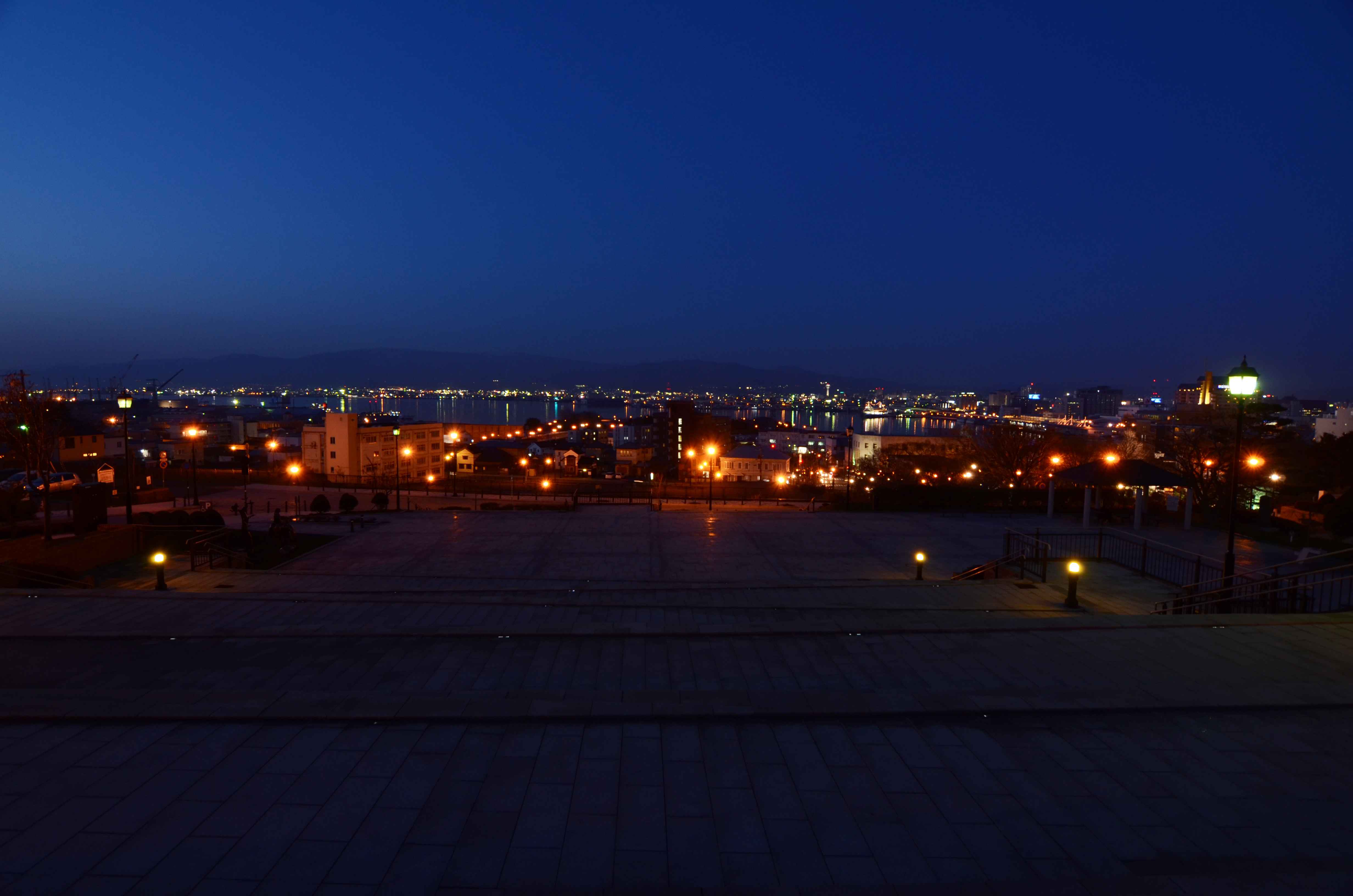
Hakodate streets at night
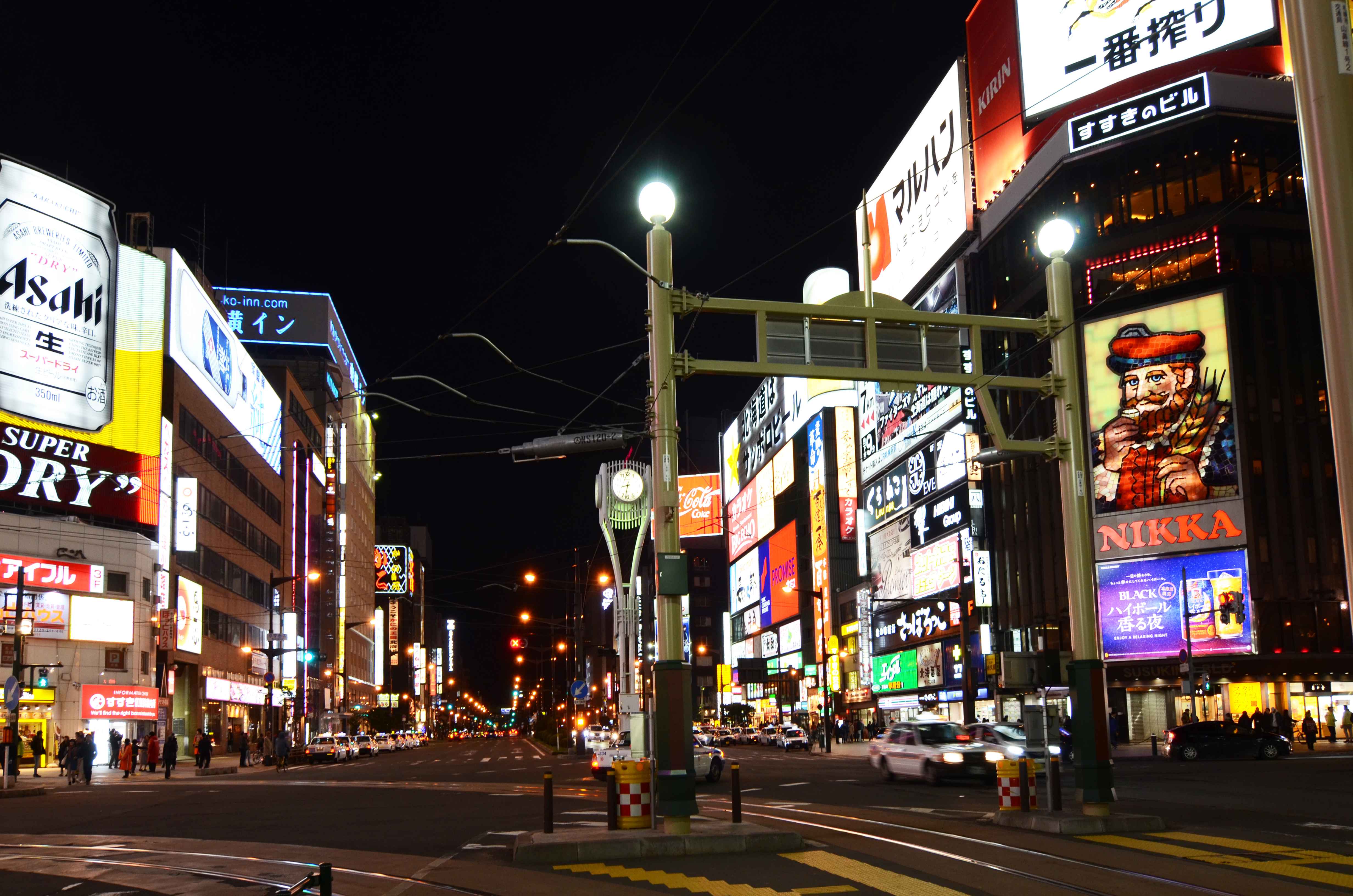
Sapporo streets at night

Well illuminated pathway to Sapporo TV tower
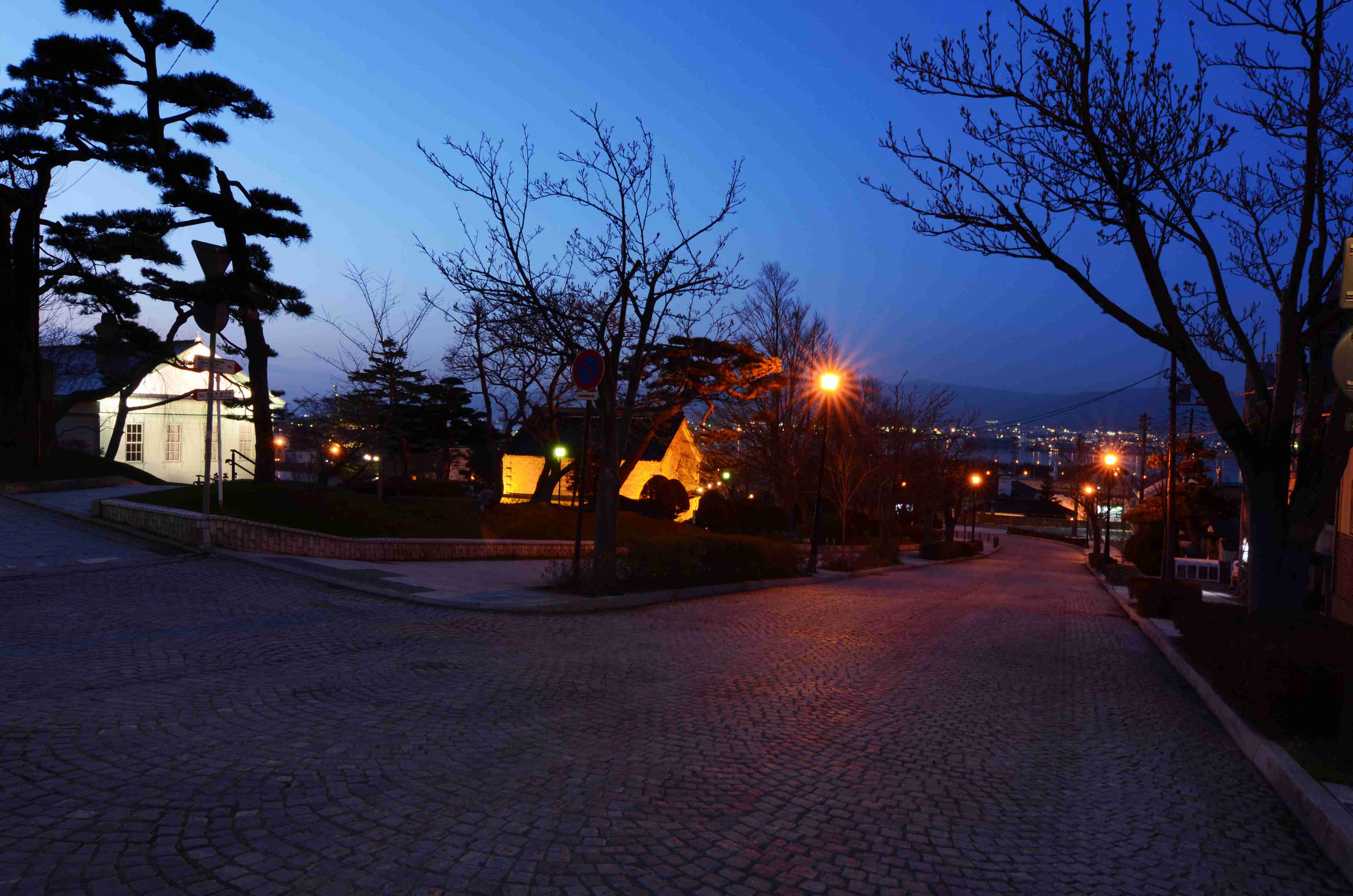
Dim pathways towards Hakodate Old Public Hall of Hakodate Ward despite many fixtures
This survey of both cities suggests that there might be a compromise between the balance of two objectives; planning for a potential attraction and planning for functional use. As Sapporo is the larger and denser city, it makes sense to cater to comfort of the people that roam the streets after working hours. From the junction pictures, you can see that there is more lighting on the floor level in Sapporo in comparison to Hakodate. Despite the numerous dotted light fixtures, we felt that the pedestrian pathways and roads were generally darker in Hakodate.
And for Hakodate, turning the nightscape into an economic tool could also be the better solution as most of the streets were empty after 1900h, with major attractions closing by then. It was also strange that Mt Hakodate was extremely crowded with tourists pouring out of the tour buses, but the streets only saw less than half the number of tourists.
Sapporo catered greatly to safety, visual comfort and an aesthetic component to differentiate areas at street level. This led to a night-view that is less readable/harder to understand from afar (Mt Moiwa) due to less light visible from that distance and therefore less light pollution. As to whether the lighting in Hakodate was planned for its night-view from Mt Hakodate, there is no concrete proof but statistics shown by the Japan Tourism Board gives it a reason to be so. Its attractive night-time view gives rise to more light pollution and glare at street level, hence the impression of its design for the macro view.
A quick analysis showed that the number of tour packages has declined from statistics provided by the Japan Tourism Board from 39.4% (2002) to 19.8% (2011), the number of tourists in Hakodate has also dropped from 5,311 to 4,108 in those years. Only in recent years when the first Google search on Hokkaido puts Hakodate and its views as 2nd most popular, did toursim rise back to 5,247 in 2017. The popularity of the internet being the main source of travel information also accounts for the emptiness of Hakodate streets at night as there are no consistent things to do at night other than the night view from Mt Hakodate. Lonely Planet even concludes it as a sleepy town with night strolls along Motomachi district as an option. Our survey of the area at night found little to no one despite countless taxis waiting around, hoping for their last ride of the day.
A possible relationship could also be drawn between light pollution and its direct economic impact. More light pollution can give a more distinct and interesting night view from afar like that of Hakodate, making it an attractive nightscape that people will pay to appreciate, as compared to that when glare is minimal as in Sapporo.
Less light pollution from prioritising visual comfort and the elimination of glare, would give more indirect benefits in supporting people to roam the streets after nightfall in comfort.
This would therefore suit the characteristics of both cities; Sapporo which is that of a busy city and Hakodate, remnants of an old port town. (Sherri Goh)
Statistics were taken from:
http://www.city.hakodate.hokkaido.jp/docs/2015062500021/files/H29irikomi.pdf
http://www.city.hakodate.hokkaido.jp/docs/2015062500021/files/h23irikomi.pdf
http://www.pref.hokkaido.lg.jp/kz/kkd/eigohokkaidokankougenkyou.pdf
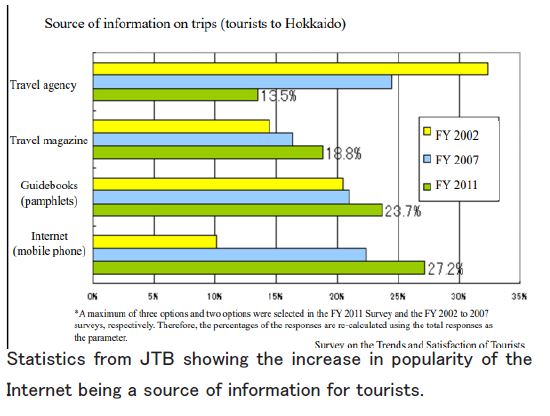
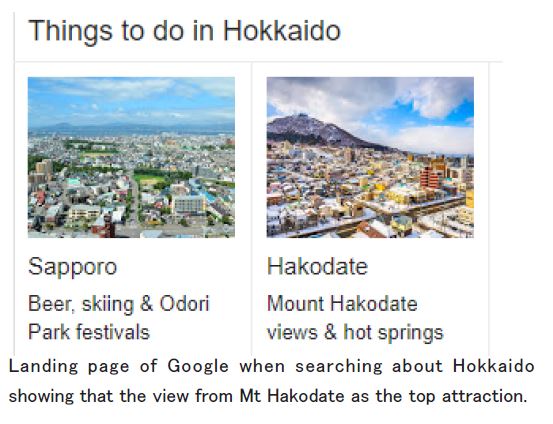
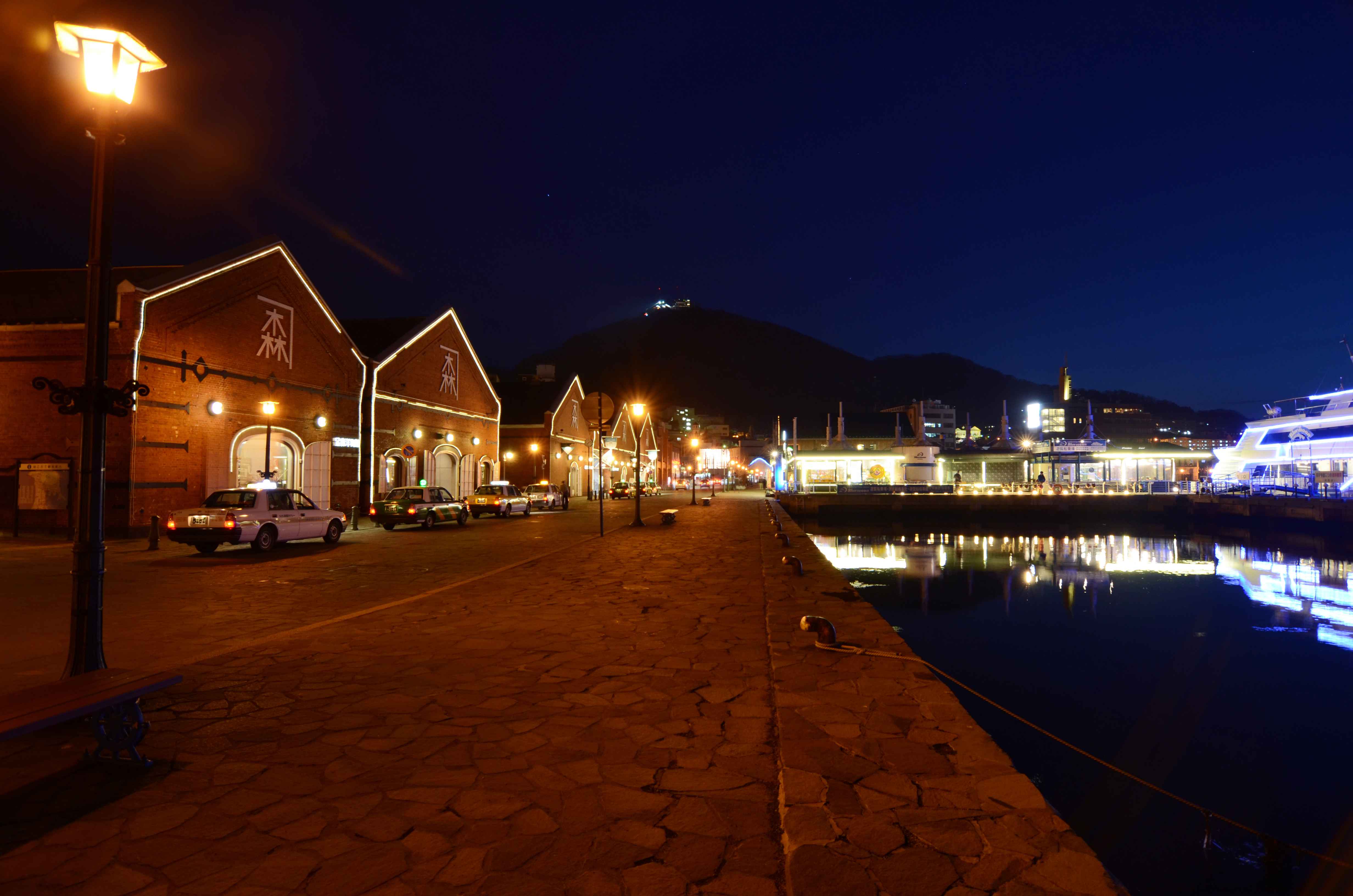
Motomachi area at night
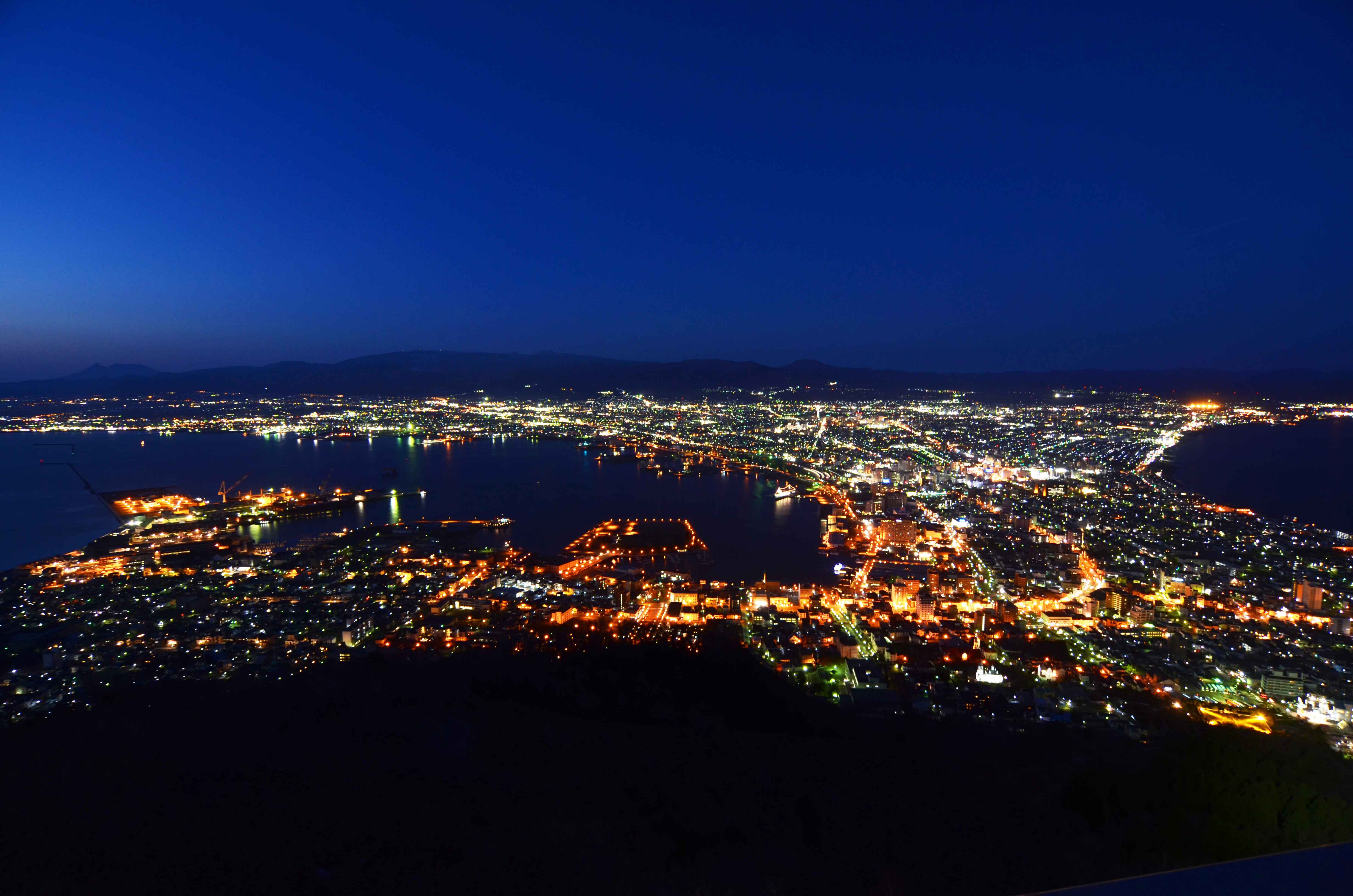
View of Hakodate from Mt Hakodate
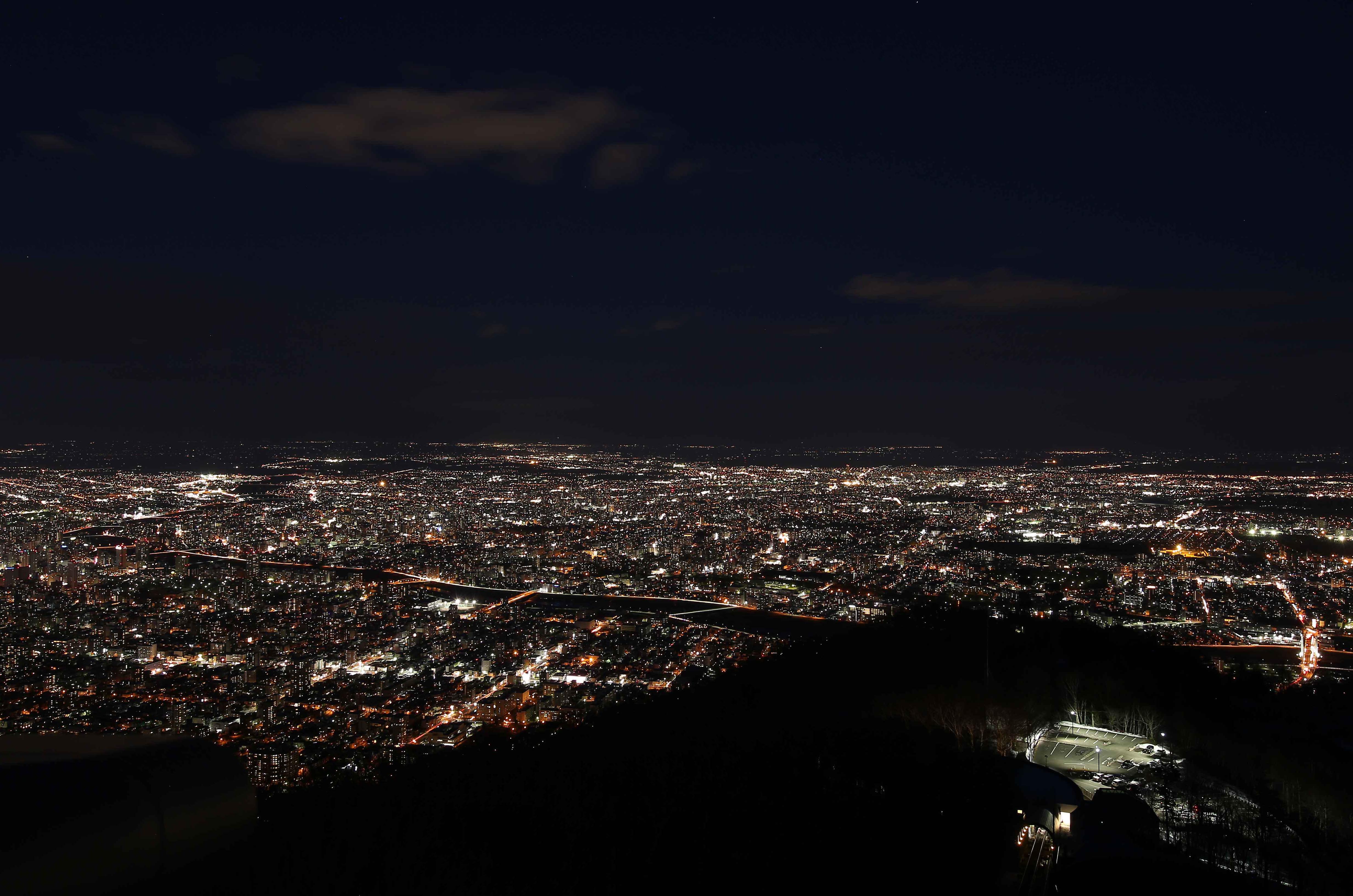
View of Sapporo from Mt Moiwa
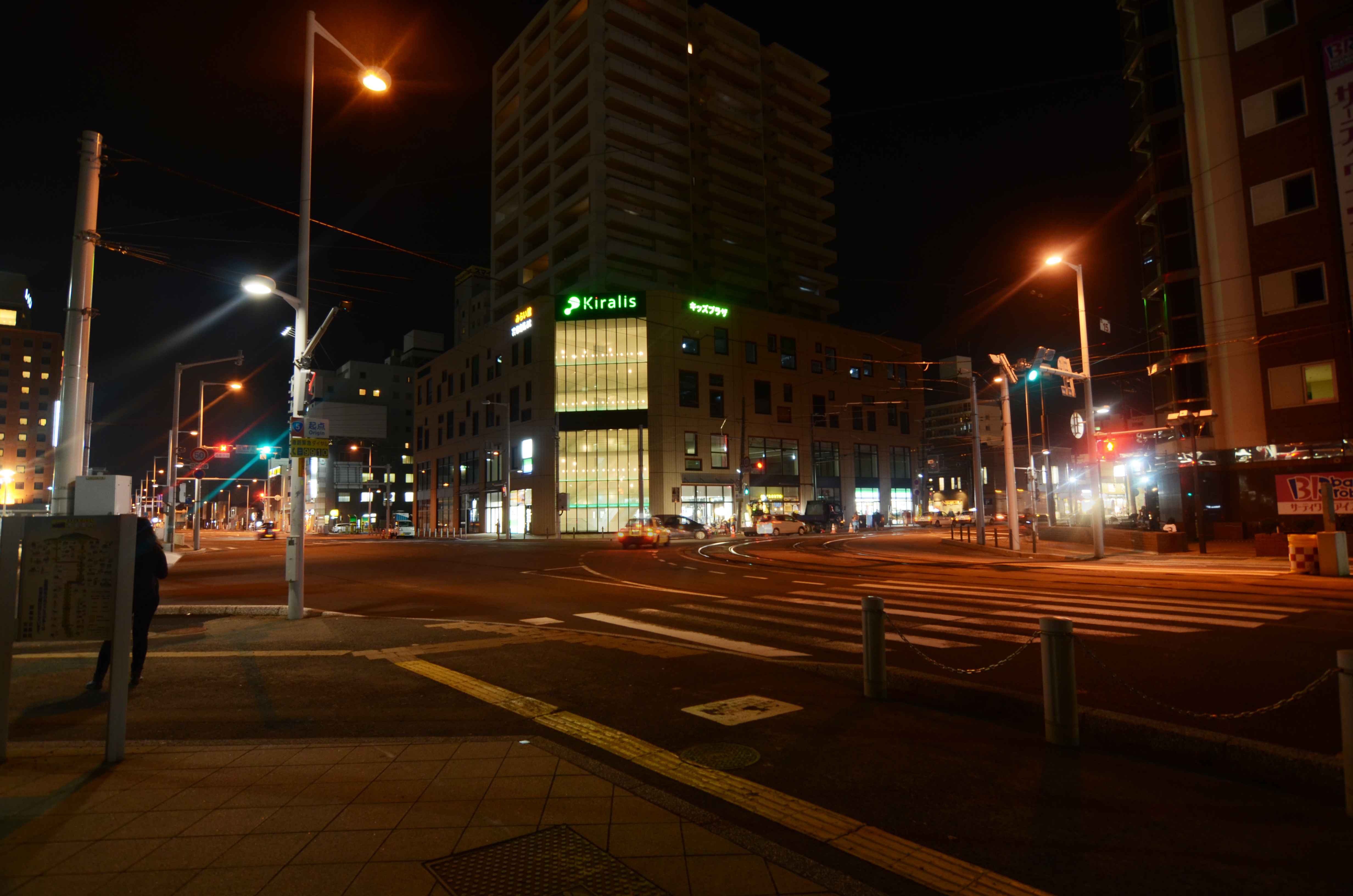
A main junction in the heart of town in Hakodate
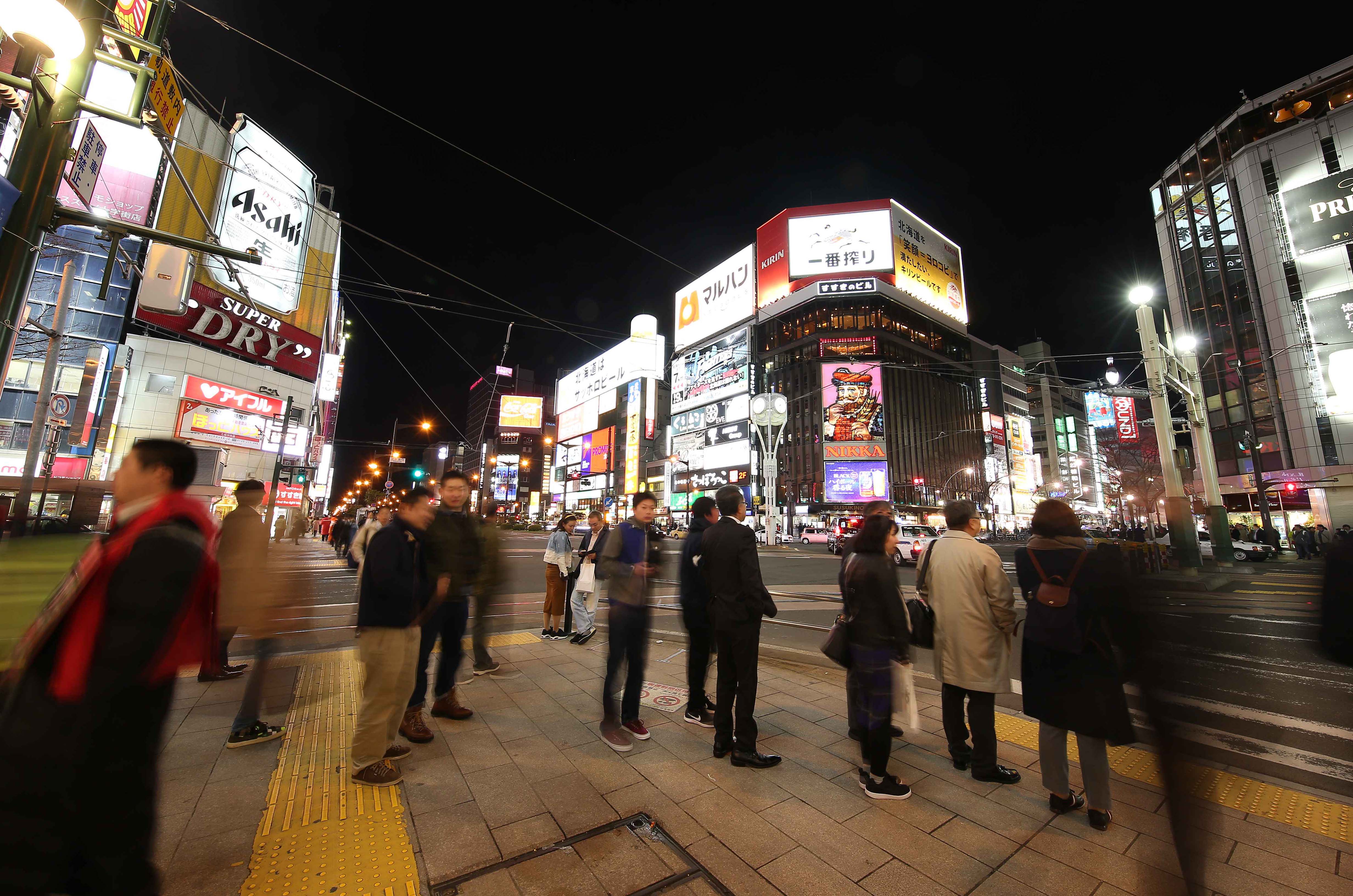
A busy junction in town of Sapporo
■夜景を楽しむための居場所
札幌は、夜景をいろいろな高さから見るのを売りにしている…とのことで、さっぽろテレビ塔の地上90mの展望台と、札幌駅直結のJRタワーの地上160mの展望台(T38)からも、夜景を俯瞰してみた。大通り公園に続くテレビ塔からは、ナトリウムランプのオレンジ色やすすきのの観覧車など、生活感のある景色を感じることができ、道路ごとに色温度や照度の計画がされている様子もわかった。T38からは、繁華街の光がビルの陰に隠れる代わりに、統一感のある整然とした光の粒が続いていく様子が、藻岩山よりもはっきりと見て取れた。展望台は、夜の遅い時間でも訪れる人々が多かった。
街を歩くと、繁華街では看板照明が鉛直面の輝度を形成していた。ただし少し中心部を外れると、光の要素がほぼ街路灯のみとなり、グレアを感じるポール灯も見受けられた。歩いて心地よい近景のためには、効率的な照度計画に加え、グレアをなくすことの徹底と、空間の奥行を生み出す明るさ感がやはり必要だなと感じた。
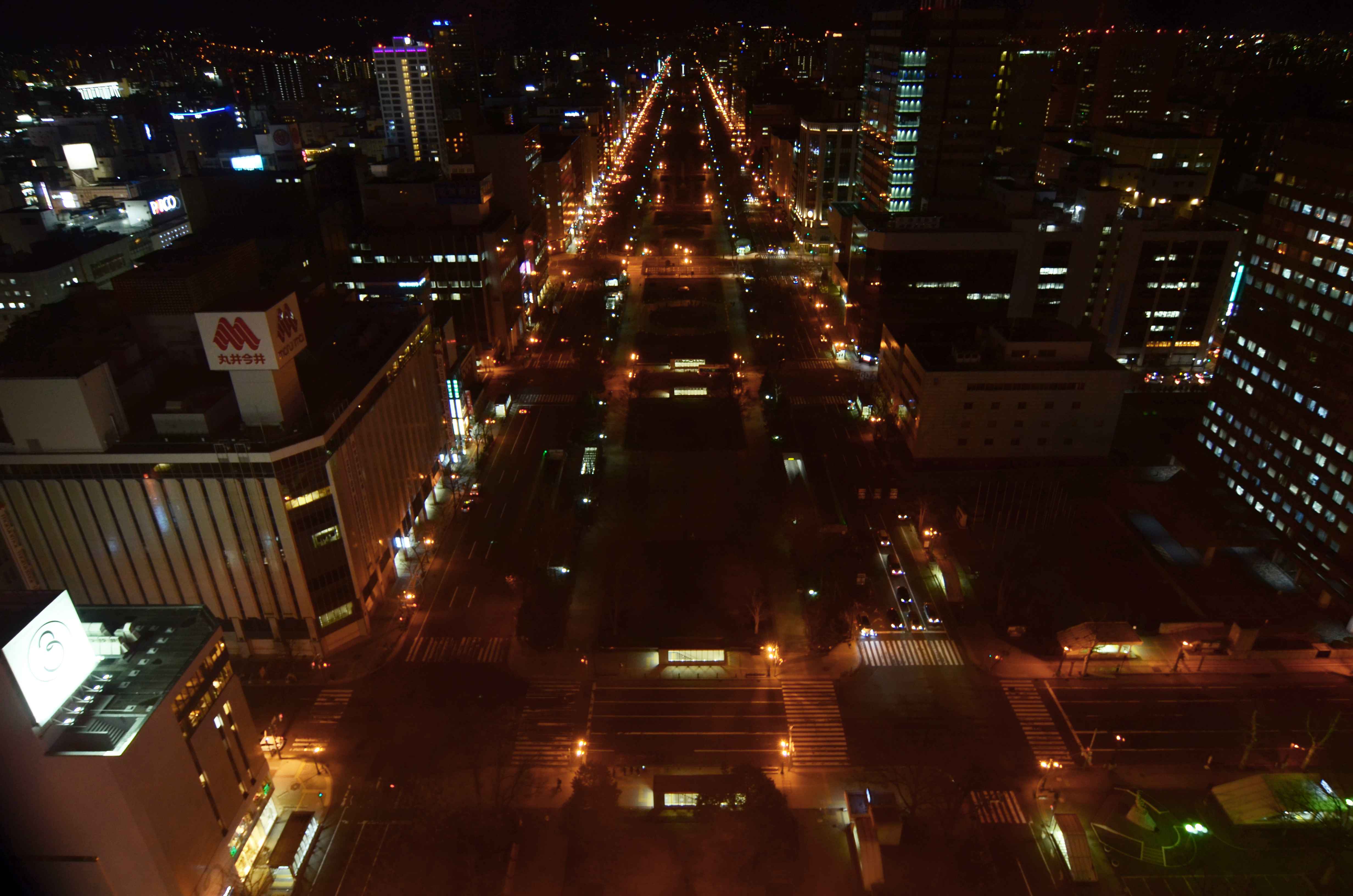
テレビ塔から見た大通り公園。道路、そして横断歩道が周囲より明るく計画されているのがわかる
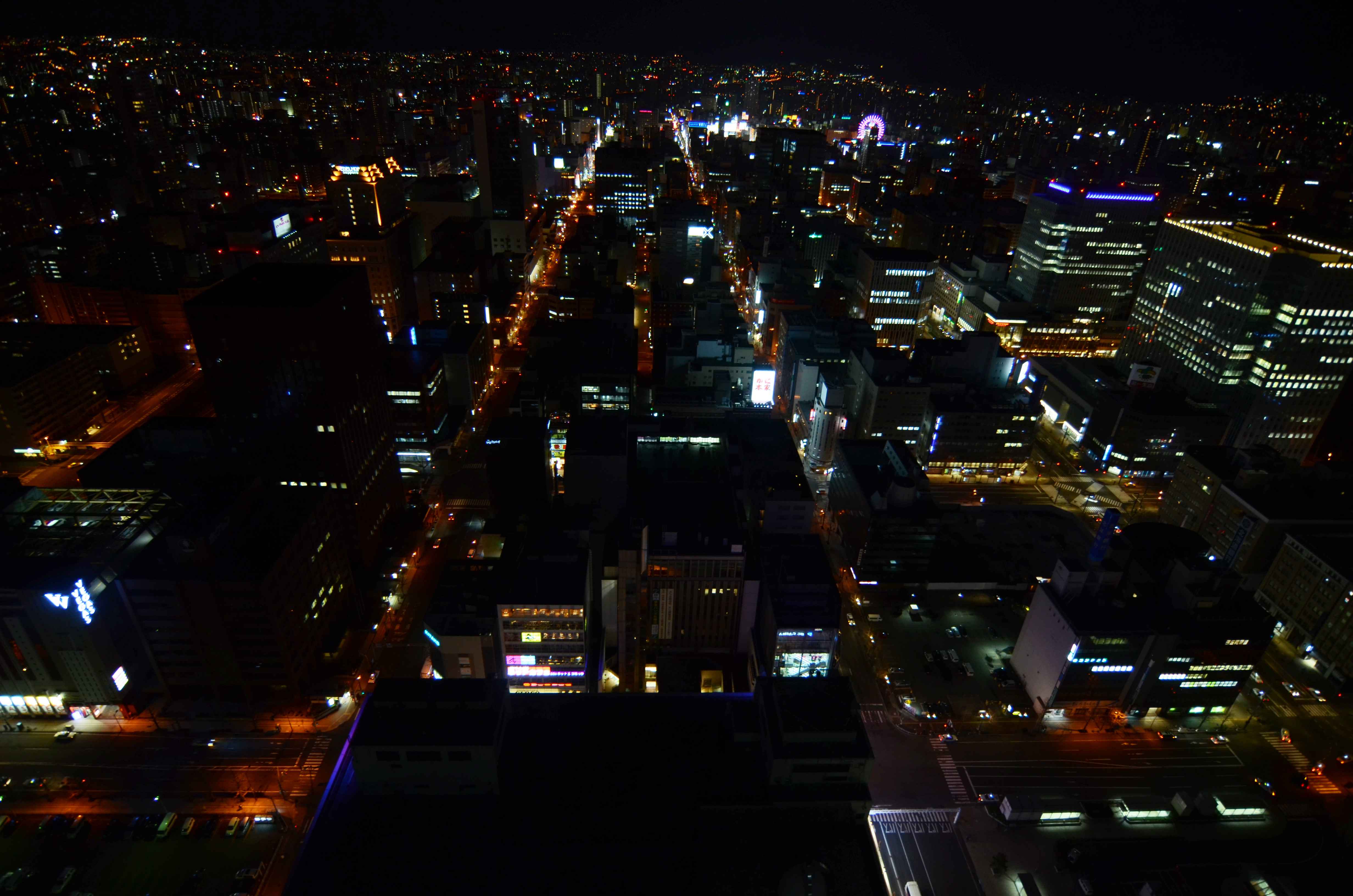
T38から見下ろす札幌の街。クラウン照明や目立ったファサード照明はあまり無い。
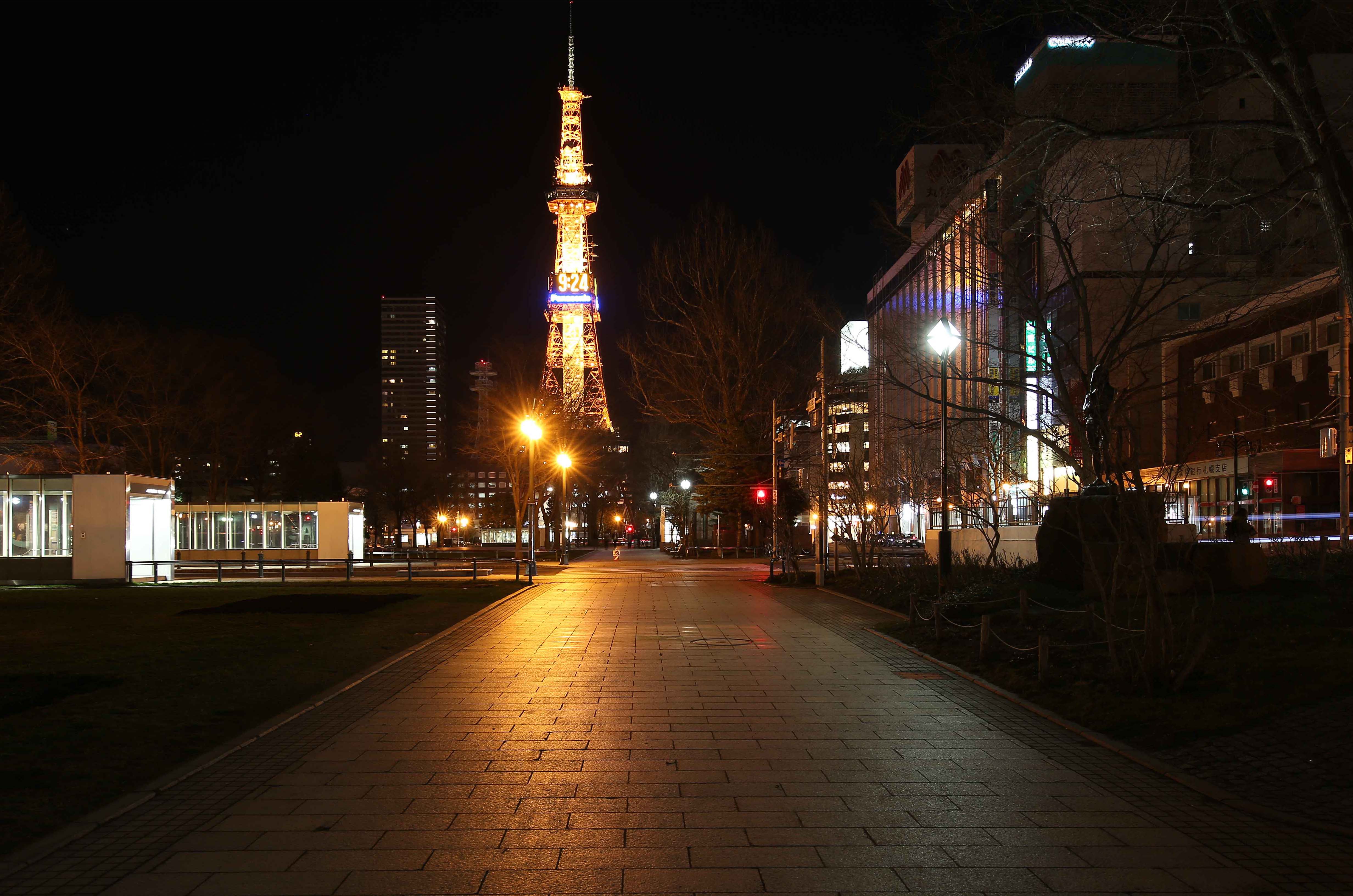
大通り公園はポール灯の輝度が目立ち、広場が逆に暗く感じられた。低い位置の柔らかい光や、鉛直面の明るさを取り入れたい。

すすきの交差点。看板照明で埋め尽くされている。人の多い繁華街でも、殆どの街路灯はナトリウムランプで、どことなく懐かしさがある。
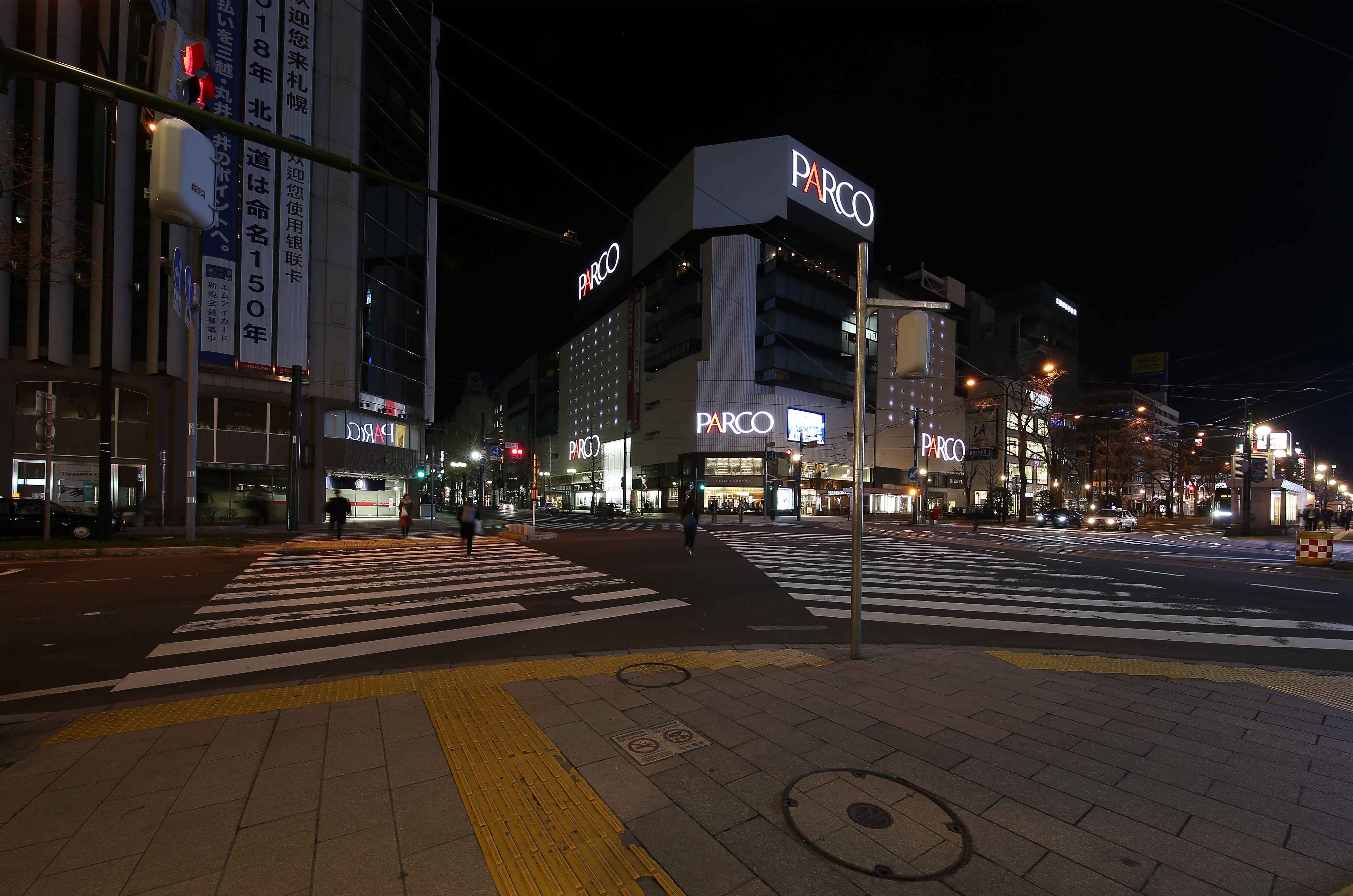
看板照明が途切れると鉛直面が暗く感じるものの、路面は30lx程度。
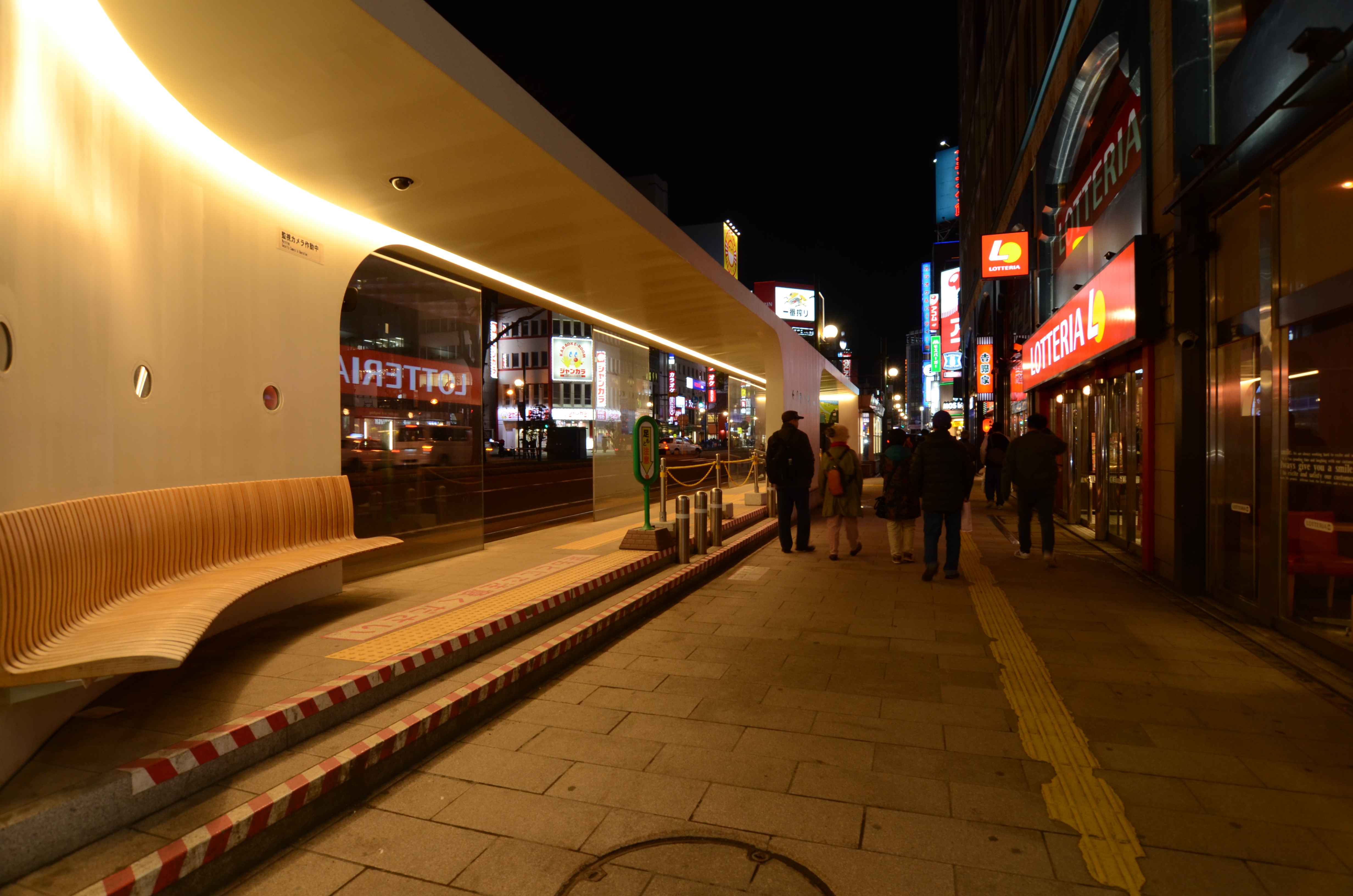
札幌市電停留所の間接照明が歩道照明としての役割を兼ねている。
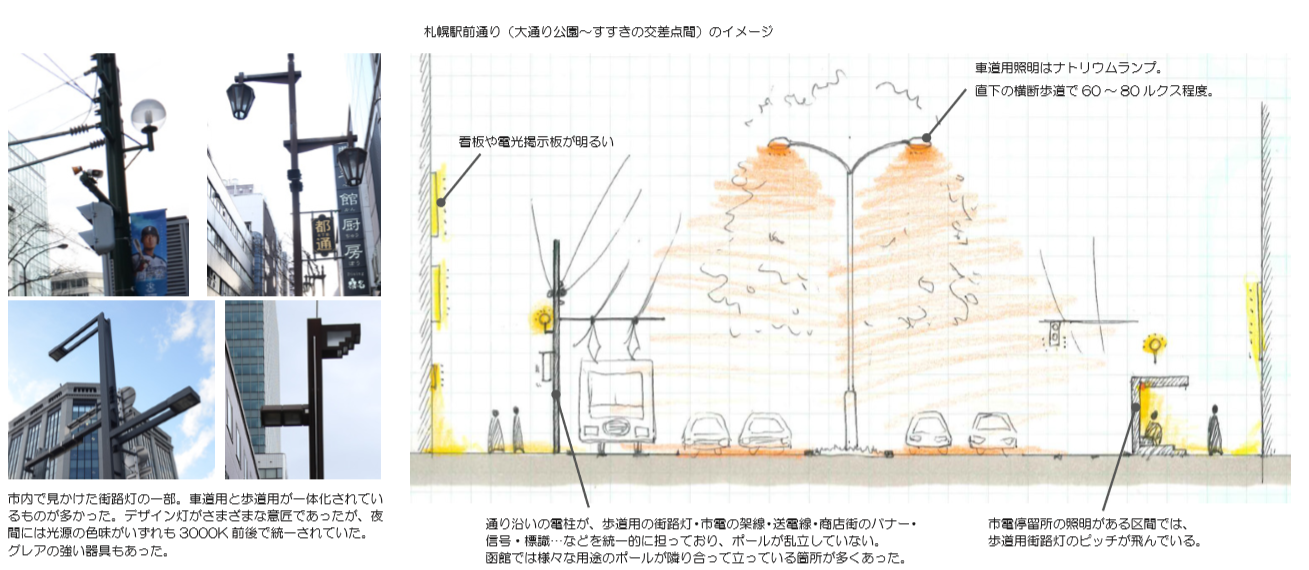
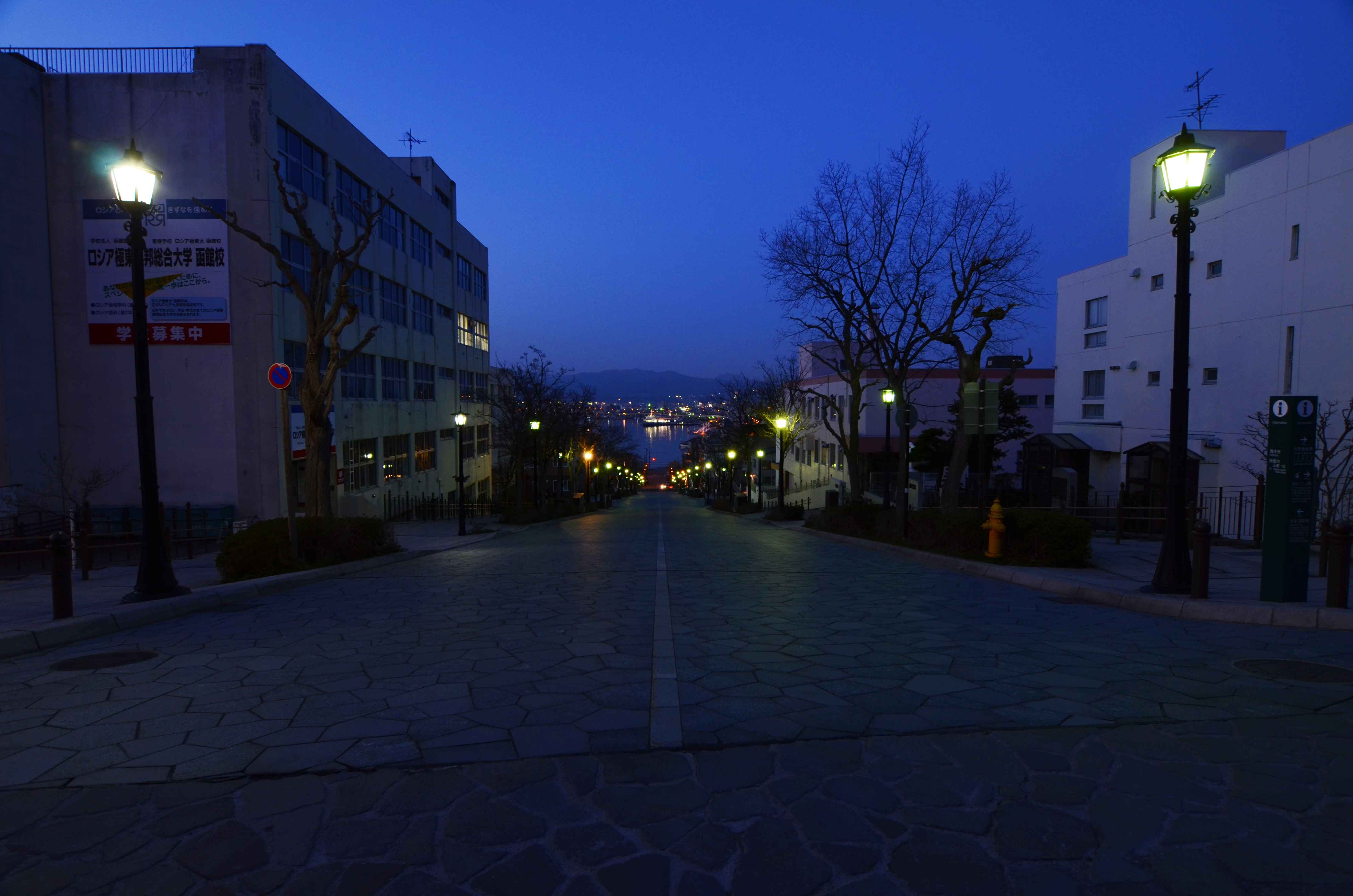
八幡坂から港を見下ろすと、視線の先には客船のライトアップ。
前景となる坂道は、鉛直面が暗く、水銀灯が白々しく、少々寂しい。
函館の街は、遠景でも有効な光の要素であったランドマークのライトアップが、街を歩いたときのアイストップにもなっていた。例えば、洋館が立ち並ぶ元町のエリアでは、坂道を見下ろすと海が見え、そこにライトアップされた船が停まっている。反対に坂道を見上げたときには、突き当りの洋館が照らされている。
ただ、夜景を楽しむ視点場が、函館山のみに集中しているように思われた。坂の上にある公園や、函館山を背景に海辺の水景を眺めることのできる海沿いの広場や埠頭も、照明は暗く、あるいは眩しく、人影もなく、夜景を見るという目的以前に、訪れたいと思わせる雰囲気に欠けていた。波音を聞きながら、石畳の道を歩きながら、ロマンチックに夜景を楽しむ、そのような場所が函館ならばいくらでも創れるはずなのに、勿体ないなと感じてしまった。見る側も見られる側も“点”という印象だった。函館らしさを夜にこそ楽しめる“線”的なシークエンスが、街にもっと生まれてほしい。(中村美寿々)
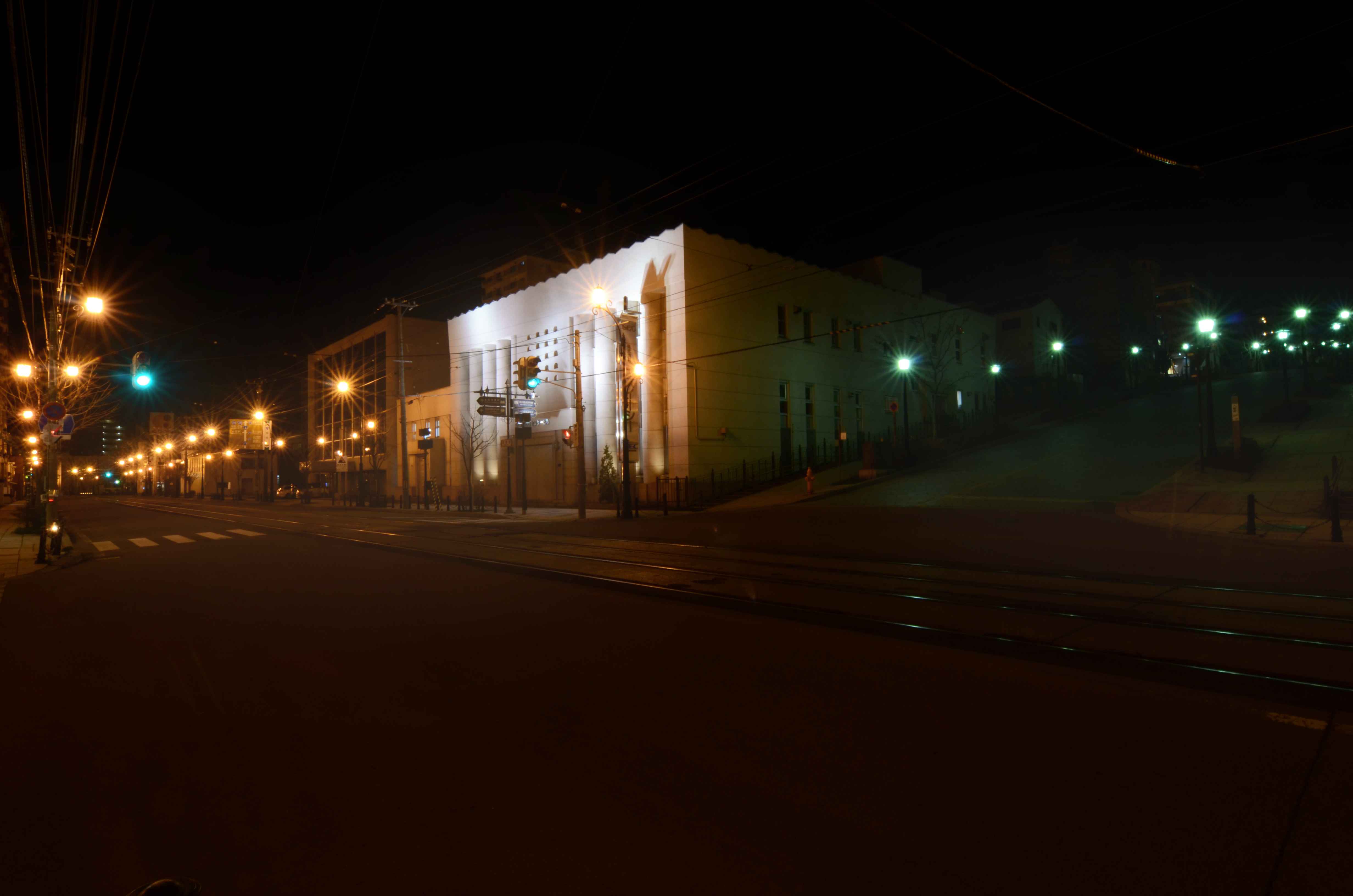
坂道は水銀灯の緑色、交差する市電の走る通りはナトリウム灯のオレンジ色。色温度がはっきりと計画されている。
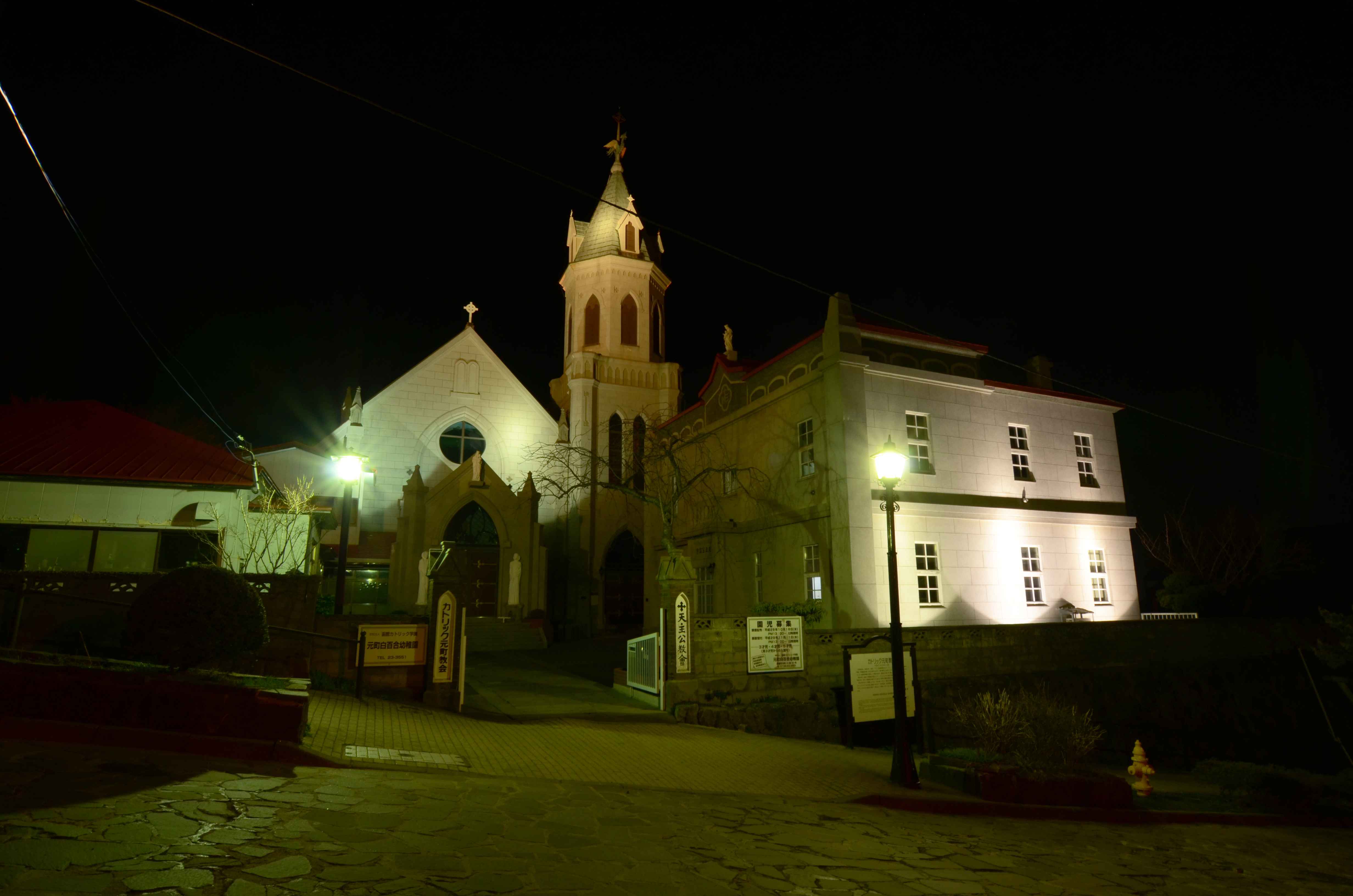
教会のライトアップ。光源はメタルハライドランプ。灯具にはルーバーが付いており、グレアへの配慮がされていた。
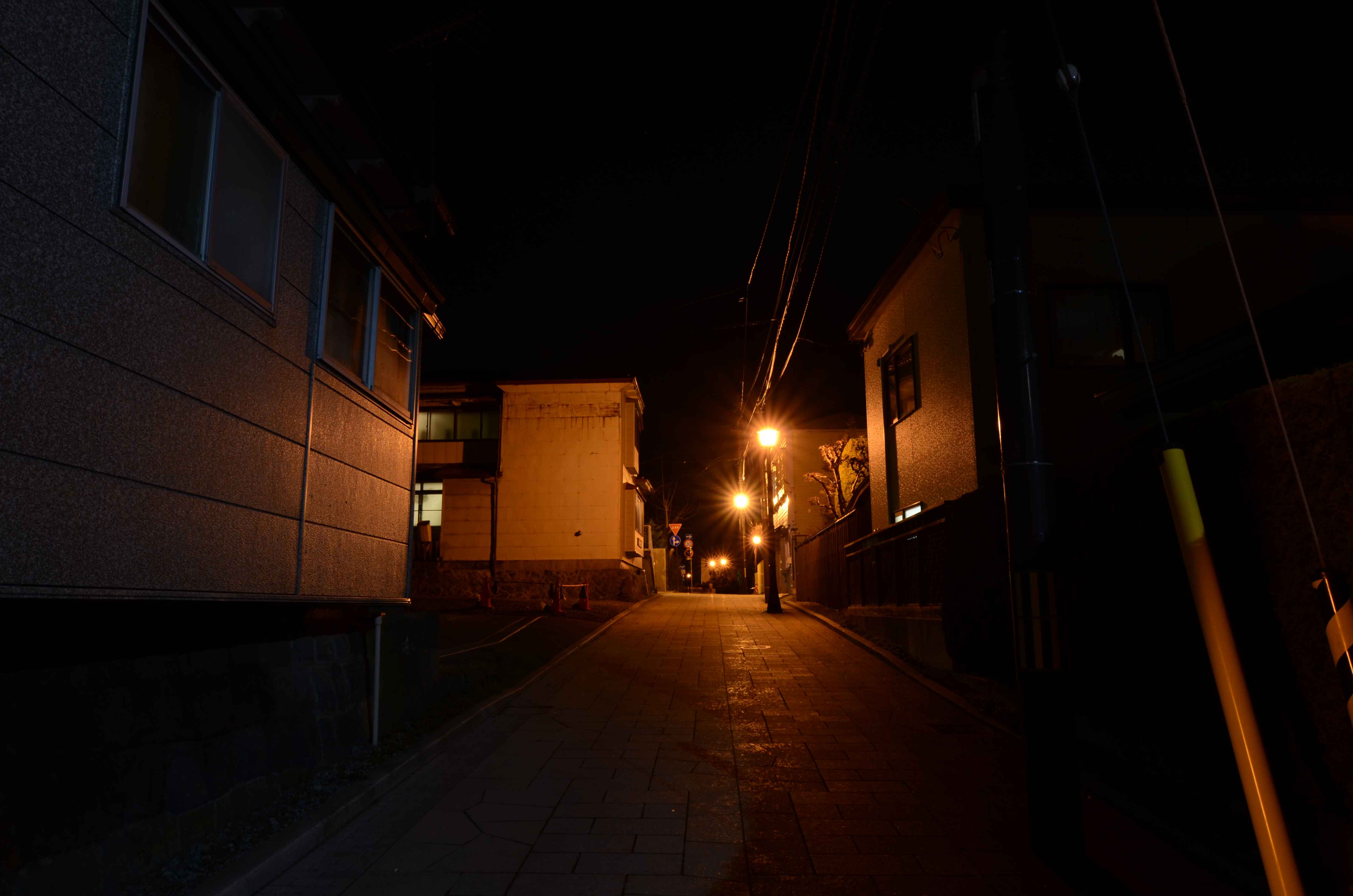
函館山からロープウェイで降りたあと、教会があるエリアへ向かう道。ナトリウム灯が眩しく、街灯直下を離れると路面は1ルクス程度。
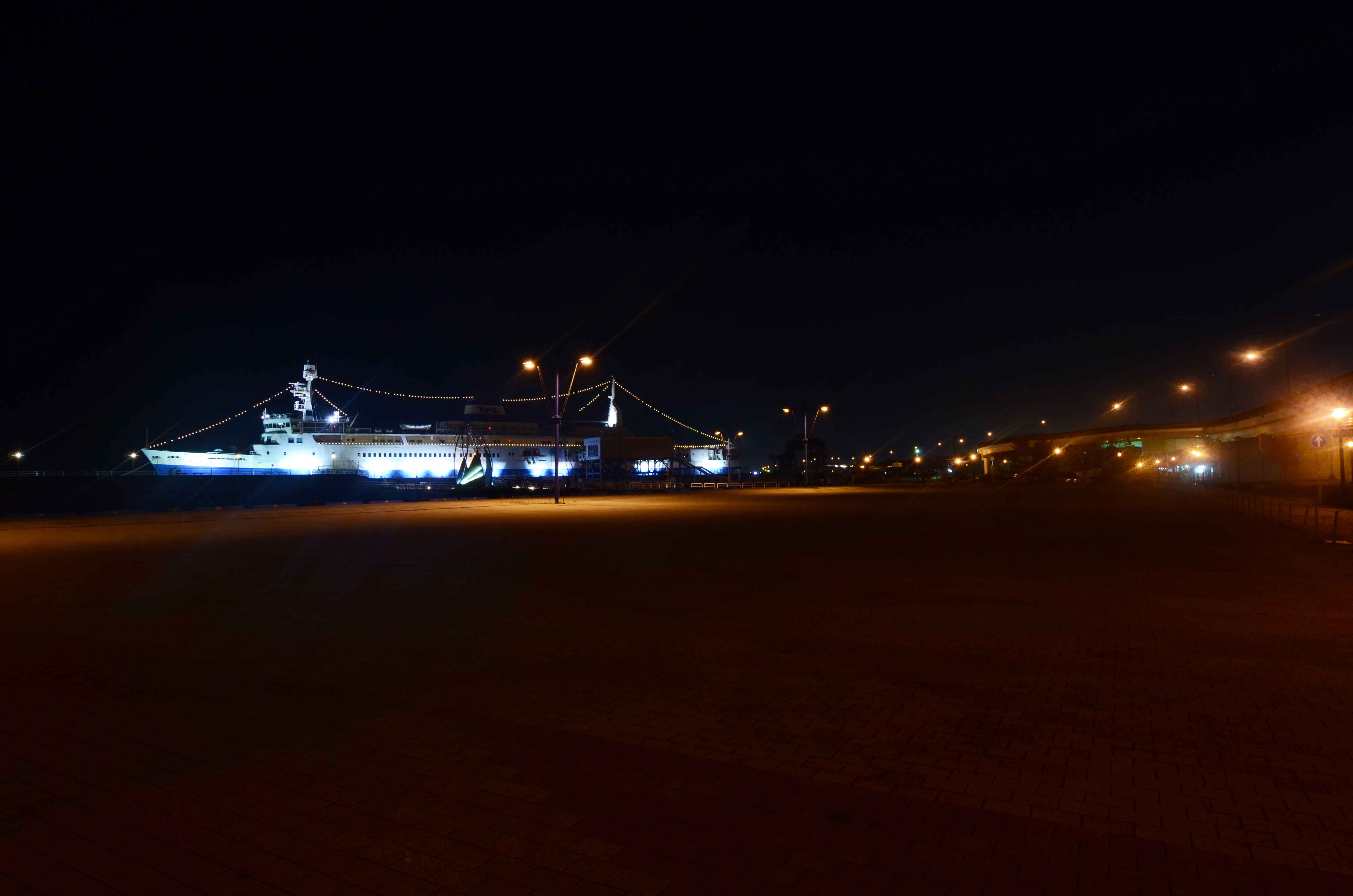
海沿いに広場が続いているが、グレアが気になり、暗く感じる。
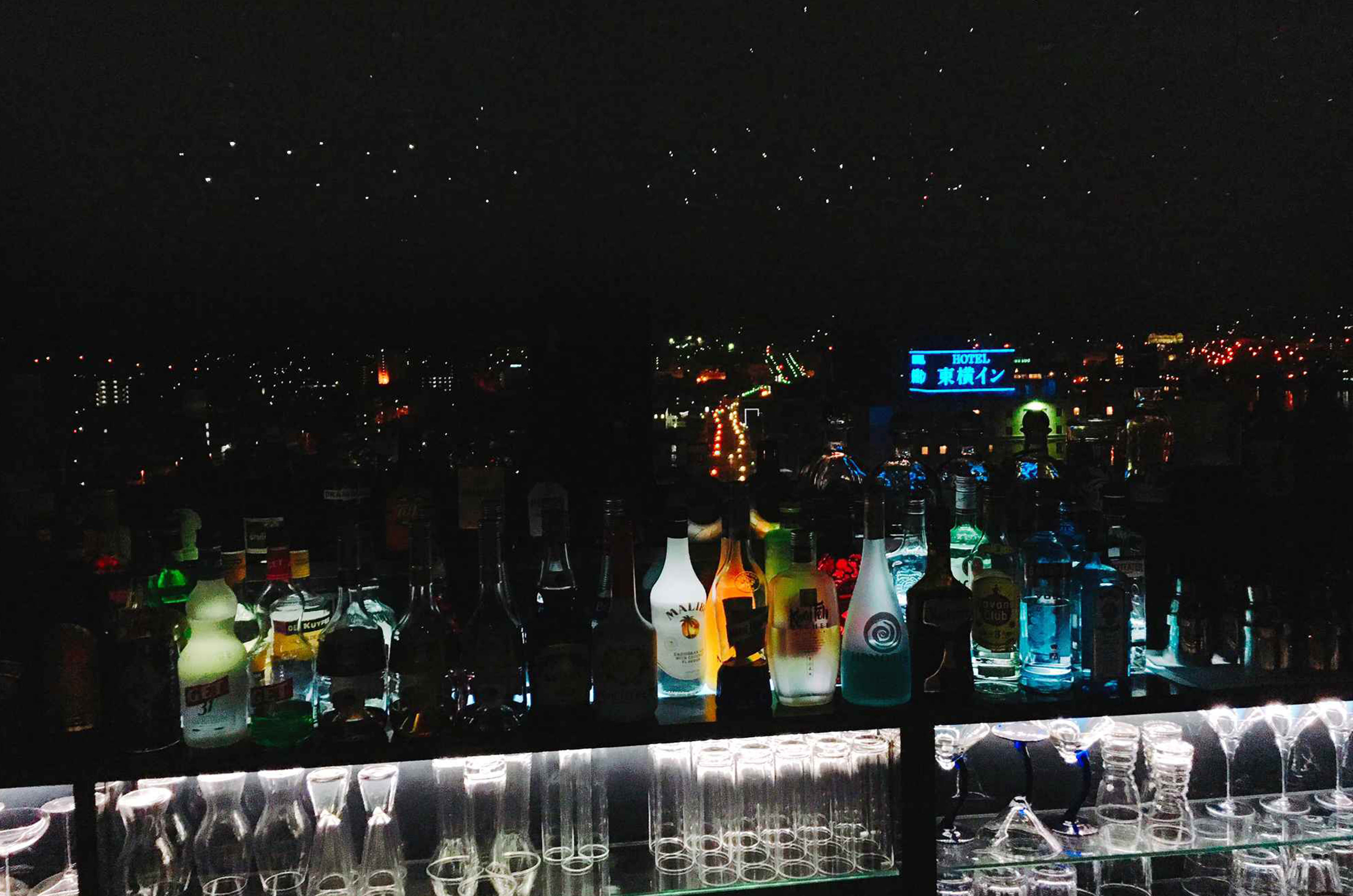
市内の「夜景バー」。映り込みへの配慮など、夜景というコンセプトを楽しめる空間。窓の外で函館山の景色が闇に沈むのが勿体なく感じた。
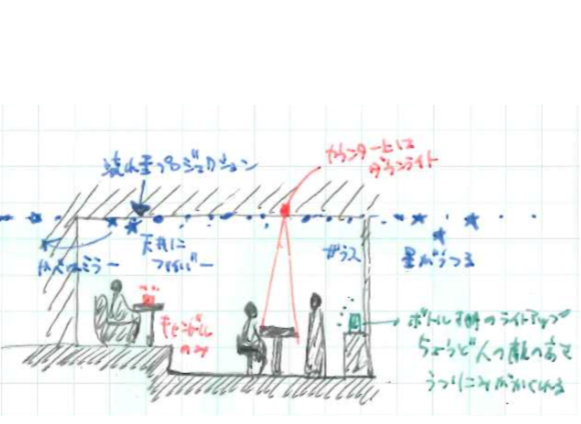

ナトリウムランプは眩しいながらも倉庫群の雰囲気には似合う。もう少し輝度が落ちると良いと思う。

埠頭からは函館山を背景に水面に映る夜景が見られるが、函館駅を挟んだ街の港側に人影はない。
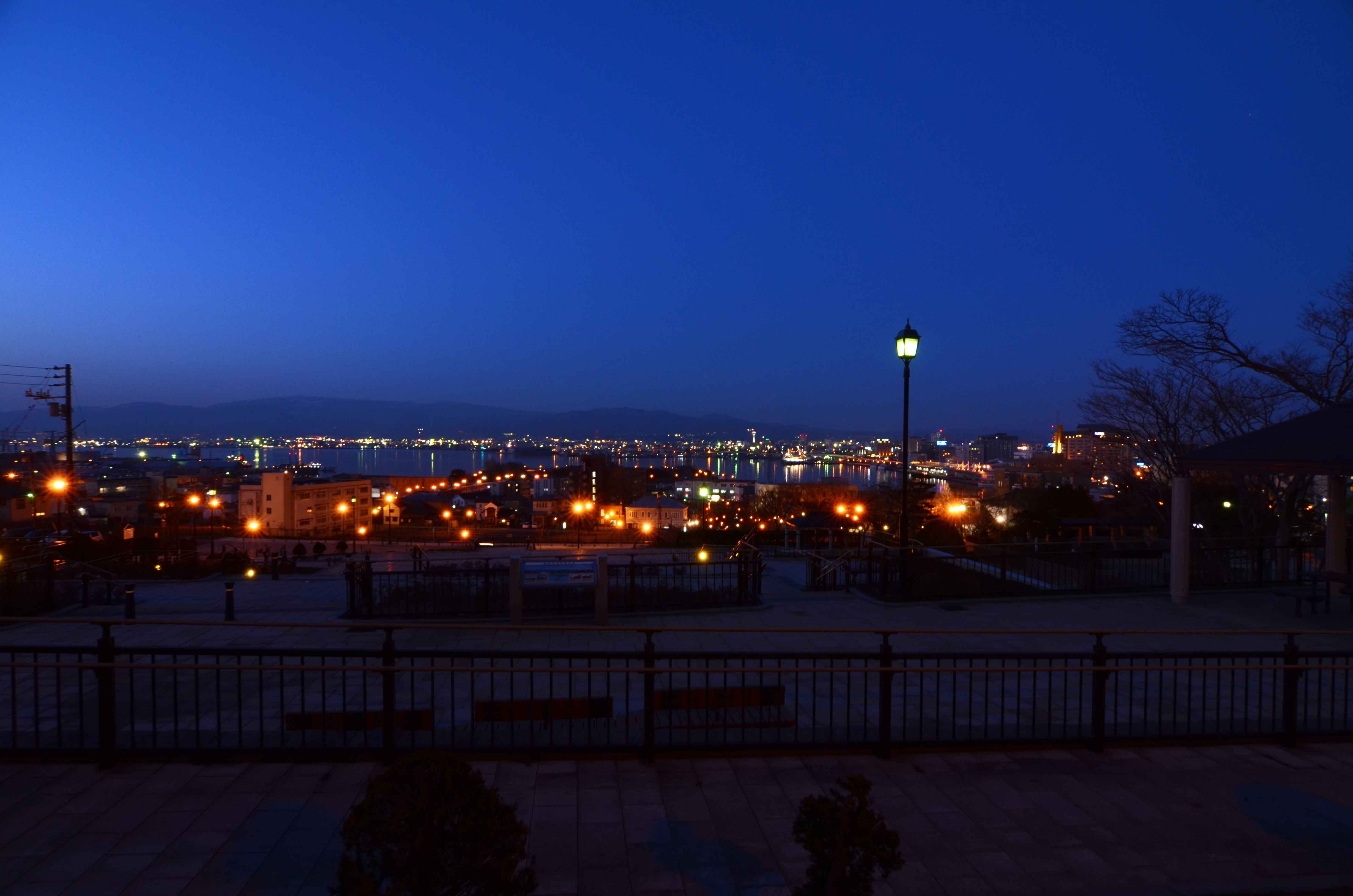
元町公園。函館山よりも街並みに近い視点から、美しい光のパノラマが見られる。階段の段差部で不点のフットライトが多く、夜間歩くために足元が安全な明るさがほしいところ。





